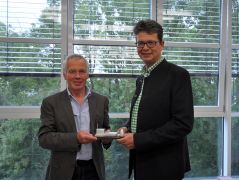MLZ is a cooperation between:
 > Technische Universität München
> Technische Universität München > Helmholtz-Zentrum Hereon
> Helmholtz-Zentrum Hereon
 > Forschungszentrum Jülich
> Forschungszentrum Jülich
MLZ is a member of:
 > LENS
> LENS > ERF-AISBL
> ERF-AISBL
MLZ on social media:

MLZ (eng)
Lichtenbergstr.1
85748 Garching
01.12.2022
A life for texture: MLZ award for Heinz-Günter Brokmeier

Prof. Dr. Martin Müller (right) and Prof. Dr. Peter Müller-Buschbaum (left) present the MLZ Prize 2022 to Prof. Dr. Heinz-Günter Brokmeier. © Reiner Müller, FRM II / TUM
Prof. Dr. Heinz-Günter Brokmeier receives this year’s prize of the Heinz Maier-Leibnitz Zentrum for instrumentation and scientific use. The 70-year-old from Clausthal University of Technology is thus honored for his early and great commitment to the material science diffractometer STRESS-SPEC at FRM II and MLZ.
Research on asse salts
Texture, i.e. how the orientation of the crystalline parts of a solid is distributed, runs through Heinz-Günter Brokmeier’s entire scientific life. Already during his studies at the Clausthal University of Technology, he determined the texture of salts in the former Asse salt mine, which was then being investigated as a repository for low- and intermediate-level radioactive waste. Laudator and MLZ director Prof. Dr. Martin Müller knows Heinz-Günter Brokmeier from his time at the Geesthacht research reactor FRG-1, where Brokmeier set up and operated two neutron instruments for texture determination. “The white beard back then fit very well with my image of a real neutron researcher and professor,” Müller said at the award ceremony.
Early use of robotics
In the late 1990s, Brokmeier poured his accumulated experience from Geesthacht and during another instrument setup in Dubna, Russia, into the STRESS-SPEC diffractometer. He accompanied the neutron instrument with its then unique combination of capabilities for residual stress and texture determination, first at the former Hahn-Meitner Institute in Berlin and then later after its move to the FRM II. In the years that followed, Brokmeier ensured that the STRESS-SPEC continued to evolve and became one of the leading devices of its kind worldwide. “It is to Heinz-Günter Brokmeier’s great credit that STRESS-SPEC focused on the use of robotics at a very early stage,” praised Martin Müller. A milestone achieved based on continuous development of the methodology is the measurement of textures with a spatial resolution below 50 micrometers using neutrons.
Neutrons have huge potential
“Very surprised” was Heinz-Günter Brokmeier about the award and at the same time felt it as a “great honor”. At the award ceremony, he explicitly included the entire STRESS-SPEC team in this. In his acceptance speech, Brokmeier emphasized that industrial cooperation was always part of his research at Clausthal University of Technology. “And neutrons played an important role in this: as soon as we could solve a problem with them, we used them.” Neutrons have a huge potential, especially in non-destructive testing, he said. Brokmeier told all those present that this potential must continue to be exploited, especially in texture determination.
Previous winners of the MLZ Award for Instrumentation and Scientific Use are:
2019: Prof. Dr. Götz Eckold
2020: Prof. Dr. Georg Roth
2021: Prof. Dr. Peter Böni
Related News
-
18.10.2019
Honour for the "Father of PUMA"
MLZ is a cooperation between:
 > Technische Universität München
> Technische Universität München > Helmholtz-Zentrum Hereon
> Helmholtz-Zentrum Hereon
 > Forschungszentrum Jülich
> Forschungszentrum Jülich
MLZ is a member of:
 > LENS
> LENS > ERF-AISBL
> ERF-AISBL
MLZ on social media:





